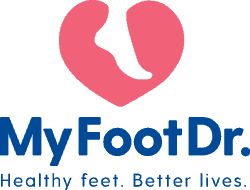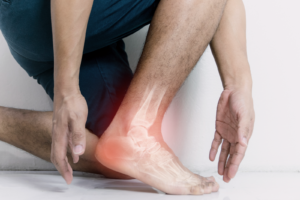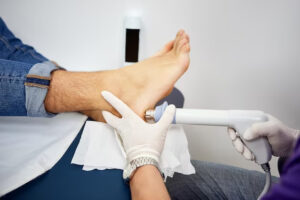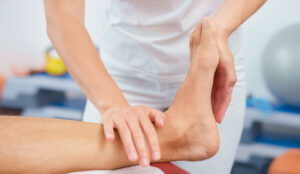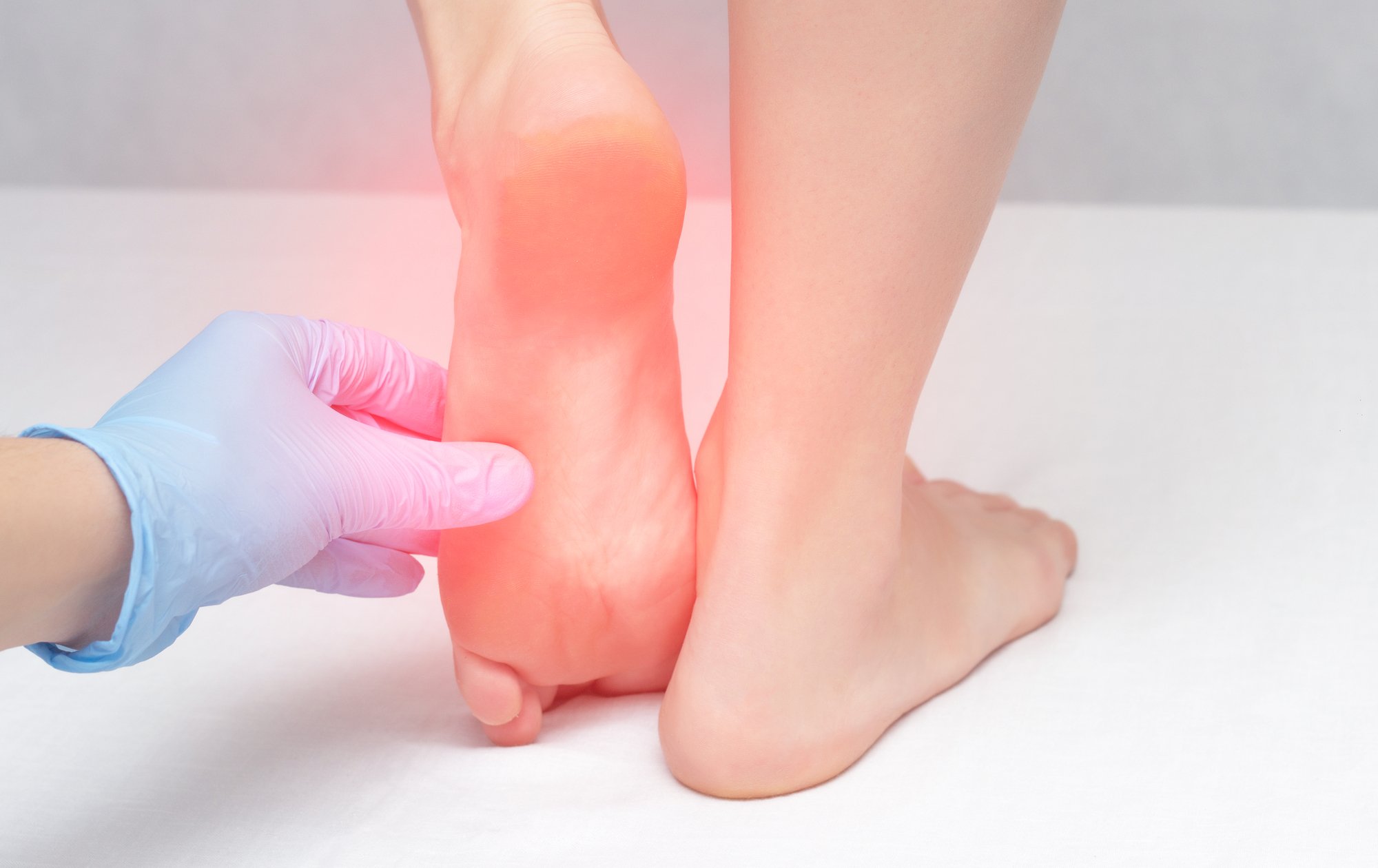
Heel pain is one of those things that can sneak up on you. You might not think much about your heels, but they do a lot of heavy lifting every day. So, when heel pain strikes, it can be more than just a nuisance – it can really throw a wrench in your daily life. This article is your guide to understanding, managing, and overcoming this common condition.
Understanding Heel Pain
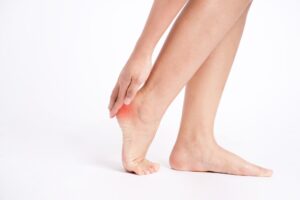
You wake up, set your feet on the floor, and ouch – there’s that sharp pain in your heel. It’s like your heel is sending you a message: “Hey, pay attention to me!” This is a scenario many face daily. Heel pain is like that uninvited guest at a party – it shows up unexpectedly and can be hard to get rid of.
Heel pain might start as a mild annoyance but can become a real thorn in your side, affecting your ability to walk, exercise, and even just move around your house (1). Whether you’re a busy parent chasing after kids, an athlete, or someone who stands a lot at work, heel pain can cramp your style.
Common Causes of Heel Pain: The Usual Suspects
The heel is more than just a simple body part. It’s a complex structure that bears the body’s entire weight every time we walk, run, or stand. All this pressure can take its toll, leading to pain. It’s like the foundation of a house – if it starts to crack, the whole structure feels it.
What Causes Heel Pain?

Heel pain is like a detective story, where the usual suspects are:
- Plantar Fasciitis: This is when the band of tissue under your foot, connecting your heel to your toes (plantar fascia), gets angry (inflamed) and starts hurting (1).
- Fat Pad Inflammation: The fat pad is a natural cushion under the heel. When this padding becomes inflamed, it’s like the shock absorbers in your heels have worn out, making every step feel uncomfortably hard.
- Achilles Tendinitis: This affects the Achilles tendon, which is like the body’s own bungee cord connecting the calf muscles to the heel bone.
- Bursitis: This happens when the bursae, little bags of fluid that cushion the heel area, get inflamed.
- Stress Fractures: These are tiny cracks in the heel bone, kind of like what you’d see in a teacup that’s been used a bit too much.
Spotting the Symptoms
Heel pain doesn’t always shout; sometimes, it whispers. Here are signs to watch for:
- A stabbing pain in the heel, especially as you get out of bed.
- A pain that creeps up over weeks or months.
- The feeling gets worse after you’ve been on your feet a lot.
- Your heel might look a bit red or swollen.
Diagnosis
Diagnosing heel pain is like solving a mystery (2). Your doctor is the detective, and your foot, the scene of the crime. They’ll poke, prod, and maybe even take pictures (X-rays, not selfies) to figure out the culprit behind the pain. It’s not just about saying “it hurts here”; it’s about piecing together the clues – your activities, footwear, and even your medical history.
The Role of Lifestyle
Your daily routine can be a big factor in heel pain. Wearing shoes that don’t fit right, being on your feet all day, or even how you exercise can make your heels shout for attention. It’s like wearing a backpack that’s too heavy – eventually, your back’s going to complain.
Treating Heel Pain
The good news is that most cases of heel pain can be treated effectively without surgery. Treatment plans are typically tailored to the individual, considering the specific cause and severity of the pain.
Conservative Treatments
- Rest and Ice: Your go-to first aid. Taking it easy and applying ice can work wonders in reducing swelling and pain.
- Stretching Exercises: Think of these as yoga for your feet. Regular stretching keeps them supple, reducing the chances of pain.
- Weight Management: It’s simple physics – less weight equals less stress on your heels. A key strategy in both preventing and easing heel pain.
- Smart Footwear Choices: Shoes can be your best friend or worst enemy. Opt for ones with good arch support and cushioning. Consider arch support sandals or orthotic sandals for extra comfort.
- Strapping Techniques: Like a hug for your feet, strapping provides immediate relief and support, lessening the strain on your heels.
- Compression Sleeves: These nifty sleeves support and improve circulation, aiding in quicker recovery and pain reduction.
- Medications: While over-the-counter pain relievers like ibuprofen or naproxen were once the go-to, it’s time for a rethink. They’re helpful but might slow down healing. Best to use them with care, and not as your first line of defense.
Advanced Interventions
Physical Therapy: It’s like personal training for your feet, strengthening muscles and building resilience.
Orthotic Devices: Custom insoles can be game-changers, providing bespoke support and pressure distribution.
Night Splints: These work overnight to stretch your foot, helping to soothe morning stiffness and discomfort.
Extracorporeal Shock Wave Therapy (ESWT): This high-tech treatment uses sound waves to promote healing, especially when other methods fall short.
Corticosteroid Injections and Surgery
Corticosteroid injections and surgery, once seen as standard options, are now recommended only when everything else has been tried. They’re powerful tools, but with significant considerations.
Alternative Remedies and Lifestyle Tweaks
Essential Oils: Adding oils like thyme to a warm foot bath can be surprisingly effective, thanks to their anti-inflammatory properties.
Reducing High-Impact Activities: Cutting down on activities that stress your heels, like excessive running or jumping, can be a proactive way to manage heel pain.
Prevention
The best treatment is prevention. By understanding what causes heel pain, you can take steps to avoid it. Regular exercise, maintaining a healthy weight, and choosing the right footwear can significantly reduce your risk of developing heel pain.
When to Seek Professional Help
It’s essential to know when to get help. If your heel pain persists despite home treatment, or if you experience severe pain and swelling, it’s time to see a healthcare professional. They can provide a proper diagnosis and treatment plan tailored to your needs.
Heel pain doesn’t have to be a part of your life. With the right approach and care, you can overcome it. It’s about listening to your body, being proactive about your foot health, and seeking help when needed. With this guide, you’re well-equipped to take those pain-free steps towards a more comfortable life.
References
- Allam AE, Chang KV. Plantar Heel Pain. [Updated 2024 Jan 4]. In: StatPearls [Internet]. Treasure Island (FL): StatPearls Publishing; 2024 Jan-. Available from: https://www.ncbi.nlm.nih.gov/books/NBK499868/
- Tu P. Heel Pain: Diagnosis and Management. Am Fam Physician. 2018 Jan 15;97(2):86-93. PMID: 29365222.
